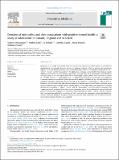Files in this item
Domains of spirituality and their associations with positive mental health : a study of adolescents in Canada, England and Scotland
Item metadata
| dc.contributor.author | Michaelson, Valerie | |
| dc.contributor.author | King, Nathan | |
| dc.contributor.author | Inchley, Jo | |
| dc.contributor.author | Currie, Dorothy | |
| dc.contributor.author | Brooks, Fiona | |
| dc.contributor.author | Pickett, William | |
| dc.date.accessioned | 2019-06-11T16:30:04Z | |
| dc.date.available | 2019-06-11T16:30:04Z | |
| dc.date.issued | 2019-08 | |
| dc.identifier | 258894907 | |
| dc.identifier | 7dd8c8ff-4724-40ac-a6f6-936d65932426 | |
| dc.identifier | 85065860140 | |
| dc.identifier | 000471197200003 | |
| dc.identifier.citation | Michaelson , V , King , N , Inchley , J , Currie , D , Brooks , F & Pickett , W 2019 , ' Domains of spirituality and their associations with positive mental health : a study of adolescents in Canada, England and Scotland ' , Preventive Medicine , vol. 125 , pp. 12-18 . https://doi.org/10.1016/j.ypmed.2019.04.018 | en |
| dc.identifier.issn | 0091-7435 | |
| dc.identifier.other | RIS: urn:65245054D9857B0C910C1E71D903726F | |
| dc.identifier.other | ORCID: /0000-0001-7321-9394/work/60196033 | |
| dc.identifier.other | ORCID: /0000-0001-8322-8817/work/65014241 | |
| dc.identifier.uri | https://hdl.handle.net/10023/17873 | |
| dc.description | Grant funding in support of this research was obtained from: 1) The Department of Health, England; 2) The Public Health Agency of Canada and the Canadian Institutes of Health Research (operating grant MOP341188); 3) National Health Service, Health Scotland. | en |
| dc.description.abstract | Spirituality is a concept with ancient roots yet contemporary relevance to mental health. Its assessment in populations of young people, however, remains an immense challenge. Efforts to perform such assessments typically involve use of unidimensional scales incorporating items related to four domains (connections to “self”, “others”, “nature”, and the “transcendent”). For adolescents, it remains unclear whether these domains equally influence mental health, or if one domain is particularly important. Here we analyzed reports from adolescents who participated in the 2014 Health Behaviour in School-aged Children (HBSC) study conducted in Canada (n = 21,173), England (n = 4339) and Scotland (n = 5603). Reports of positive mental health were modelled as a function of ordinal scores describing each spiritual health domain, controlling for age, the other domains, and potential confounders. Subsequent analyses focused on the centrality of connections to “self” in these relationships. We identified strong and consistent associations between positive mental health and higher scores for each of the four spiritual health domains. In fully adjusted models, these effects were diminished or changed direction for connections to “others”, “nature”, and the “transcendent”, while the positive association with “connections to self” remained. While associations exist between each of the four domains of spiritual health and positive mental health, it appears that associations with connections to “others”, “nature”, and the “transcendent” are sometimes mediated by connections to “self”. Implications for assessment, models and related interventions and health promotion strategies, based on the idea that inner connections may be central to the protective effects of spiritual health, are considered. | |
| dc.format.extent | 352885 | |
| dc.language.iso | eng | |
| dc.relation.ispartof | Preventive Medicine | en |
| dc.subject | Adolescent | en |
| dc.subject | Child development | en |
| dc.subject | Gender | en |
| dc.subject | Mental health | en |
| dc.subject | Psychosomatic | en |
| dc.subject | Spiritual health | en |
| dc.subject | RJ101 Child Health. Child health services | en |
| dc.subject | NDAS | en |
| dc.subject | SDG 3 - Good Health and Well-being | en |
| dc.subject.lcc | RJ101 | en |
| dc.title | Domains of spirituality and their associations with positive mental health : a study of adolescents in Canada, England and Scotland | en |
| dc.type | Journal article | en |
| dc.contributor.institution | University of St Andrews. School of Medicine | en |
| dc.contributor.institution | University of St Andrews. Population and Behavioural Science Division | en |
| dc.contributor.institution | University of St Andrews. Child and Adolescent Health Research Unit | en |
| dc.identifier.doi | 10.1016/j.ypmed.2019.04.018 | |
| dc.description.status | Peer reviewed | en |
This item appears in the following Collection(s)
Items in the St Andrews Research Repository are protected by copyright, with all rights reserved, unless otherwise indicated.

